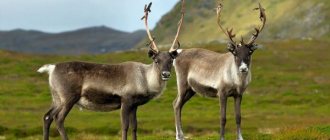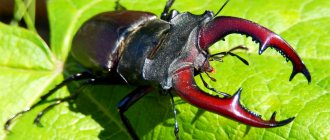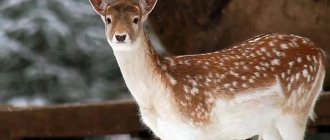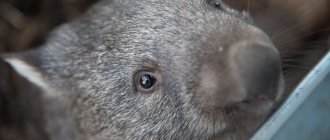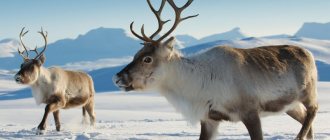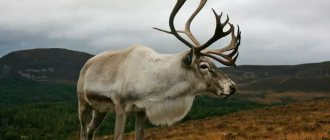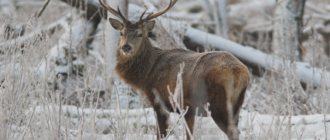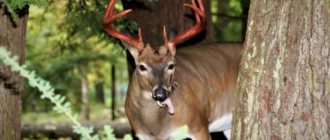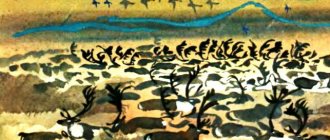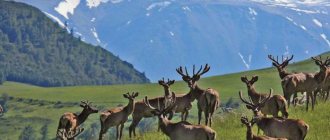General information
Among the deer that belong to various subspecies, you can find animals whose size at the withers varies from 37 to 235 cm, with the body length ranging from 95 to 315 cm, and weight - 8-830 kg. The main external features that unite all animals into one family are the proportional structure of the body and posture, which looks quite noble.
But not all varieties have long legs. All species are characterized by muscular limbs and fingers that are placed on the sides. The deer's tail is quite small, so when looking at pictures, it cannot be seen from all angles.
A distinctive feature of almost all animals is horns. But in many subspecies they grow only in males. And only reindeer have these frontal processes in females, although they are much smaller in size. Horns are not immediately weapons. At first they are cartilaginous protrusions, and over time they become overgrown with bone tissue. Moreover, the rate of their growth and subsequent size depends both on the species and on what the animal eats.
Interesting fact: Not all varieties have branched antlers. In water deer, neither males nor females have them at all. This is the only antlerless subspecies that belongs to the deer family.
Forest deer shed their antlers every year, then new ones grow - more branched. The animals' fur is thick and dense, covering almost the entire body. In winter, the hairline becomes longer, which makes it easier to withstand frost. Deer ears are brown and tend to go up.
Many deer are short-haired, and the coat color can be tan or tan. Some species have a weakening of color on the back of the legs, so a light spot is formed, which is called a “mirror”. And the skin of spotted species is dotted with white round spots, which from a distance look like glare from the sun. Deer hooves are greatly expanded, all fingers are well developed and function all the time.
Interesting fact: In most subspecies, newly born fawns are spotted until a certain age, while adults have a uniform color with slight lightening on parts of the body.
Natural enemies of reindeer
Reindeer are most vulnerable during their migrations, when even adult individuals are attacked by predators such as wolves, wolverines, lynxes and others. But the greatest harm to the population of this animal is caused by people, namely, uncontrolled hunting and poaching for the purpose of obtaining antlers (young horns).
Lifestyle
Many subspecies that live in the northern regions are nomadic. In the summer, they find food in forest clearings, and in winter they go into the thicket, since it is easier to find areas that are not heavily covered with snow, this makes it easier to find food and helps them move faster when escaping from predators.
Contrary to the persistent stereotype of deer as a brave animal, many of them have a timid character. They do not allow you to get close to them, and a loud sound can put an entire herd to flight. Also, aggressive individuals are often found among different subspecies. Even among fawns, the games of young animals look less like innocent entertainment for children, and more like a real fight.
However, despite their aggressiveness towards rivals, adult individuals, even during fierce fights, do not often cause severe injuries to each other. As a rule, fights are limited to either a clash of horns, or a reminiscent of boxing, when males, standing on their hind limbs, fight with their front legs.
Interesting fact: But females actually show courage when it comes to protecting their young. The female will without hesitation rush at a predator that has attacked a fawn.
Most often, deer live in small herds of 4–7 individuals. Moreover, each group is assigned its own territory, which they protect from strangers. To mark the boundaries of their properties, animals mark areas with special glands located between their toes.
Animals that live in the mountains, with the onset of frost, descend lower from the high-mountain forests: to places where there is less snow. Moreover, females with their cubs are the first to leave for the winter, and males join later.
Since deer have many enemies in their natural environment, they have learned to run quite quickly. For example, a North American deer or wild fallow deer (a subspecies of deer) running away from wolves can reach speeds of about 65 km/h.
Distribution of reindeer
— Advertising —
According to their habitats, reindeer are classified into tundra, forest and mountain reindeer. These names correspond to where this or that population lives. Tundra deer live in the tundra, forest deer prefer forests to live, and mountain deer are found in the mountains. This division is rather arbitrary, since this species is prone to frequent migrations and constantly changes its places of residence.
The reindeer's habitat includes North America, Russia, Kamchatka, northern Canada, Alaska, Sakhalin and Taimyr. This is why this species of deer received the name northern, since it primarily lives in the harsh northern climate.
Difference from roe deer and elk
Despite the external similarity of roe deer and elk to deer, they have many differences.
The moose is distinguished by the following characteristics:
- Withers in the form of a hump.
- Quite thin and long limbs, strongly contrasting with the massive body, unlike deer.
- A massive upper lip that partially covers the lower lip.
- Hump-nosed, rough and large head.
- Pointed hooves.
- A leathery growth under the larynx called an “earring.”
- Coarser coat.
- Large spreading horns, similar to a plow, because of this they are often called plows.
- Moose are faithful to one partner all their lives, unlike many other subspecies of deer.
Moose most often live alone or in groups of 2-3 individuals. These animals do not form a group, as happens with deer. Most often, moose herds are knocked down when other single females join the mother with her calves. But after a while the herd disintegrates.
The difference between roe deer and deer:
- More vertical development of horns that have sharp ends.
- Sexual dimorphism is not pronounced: females are slightly smaller than males.
- Female roe deer can delay pregnancy for up to six months in order to give birth to offspring in more favorable weather conditions.
- In summer, roe deer lead a family or solitary lifestyle, but in winter they create herds of 12–17 individuals.
- The head of a roe deer is much larger, shorter and not so graceful in shape.
Interesting fact: Small roe deer, like fawns, have spots on their skin, this helps them hide in the forest from predatory animals.
Types and names
The family includes three subfamilies, where there are 51 species. If we consider the varieties of real deer, the main ones are as follows:
- Reindeer (caribou). The animal lives in the tundra, and both females and males have horns. With their help, they clear the snow to get to lichens and moss. In addition, this is the only class of deer that can eat meat, usually small rodents.
- Red deer (the species is divided into the following subspecies: wapiti, wapiti, red deer). The most beautiful representative of deer. There is a white spot under the tail. The horns are characterized by great branching. It lives over a wide geographical range, from Europe to Australia.
- Pudu is the smallest species. There are only a few varieties in the genus: northern and southern puda. It has short, thick fur of a brownish-brown color, the muzzle and back are slightly darker, and in some cases almost black.
- Water or antlerless deer. It is also one of the smallest species. Lives in the forests of the Korean Peninsula and China. This is an excellent swimmer who can cover distances of 2-3 km.
- The Ceylon spotted deer is a subspecies of the Axis. Lives only in Sri Lanka. Animals are active mainly early in the morning and late in the evening, but can be found near watering holes at any time of the day. They feed on grass, fruits and leaves. The herd can contain up to 120 individuals.
- The tufted deer has a black-brown tuft on its head, hence its name. A distinctive feature is the unbranched and very short horns. Lives in the forests of Asia.
Offspring and reproduction
The rut of animals begins at the beginning of autumn and lasts until approximately December. At this time, harems are organized, which consist of 1 male and 2-20 females. At the same time, fights often begin when rivals find out who is stronger and worthy to procreate. Battles do not often end in severe injuries, but it happens that animals break their horns this way or, having intertwined them, they are unable to disengage, and therefore they die of hunger.
Interesting fact. Rarely, males have hornless animals. They do not fight, because they have nothing to fight with, but pretend to be a female and fraudulently try to penetrate someone else’s herd and copulate with one of the reindeer, while the “owner” of the harem sorts things out with his rivals.
Pregnancy in females lasts approximately 8 months, cubs are born in the warm season: from late spring to mid-summer. A female deer usually brings one, rarely two, babies. She feeds them with milk for quite a long time, sometimes for a year, although from as early as a month the fawns can feed themselves, eating moss and other food.
At approximately one year of age, males begin to erupt with horns, as evidenced by the formation of tubercles on the forehead. The first horns, which do not yet have branches, are shed with the arrival of next spring. Every year the horns begin to become more powerful and strong, and the number of processes on them increases all the time. Animals mature differently based on gender. Females reach sexual maturity at 1-1.5 years, males much later - at 2-3 years.
Notes
- ↑ 1 2 3 Wilson DE & Reeder DM (eds).
Mammal Species of the World.
— 3rd ed. - Johns Hopkins University Press[en], 2005. - Vol. 1. - P. 743. - ISBN 0-8018-8221-4. OCLC 62265494. Archived copy (unspecified)
(link unavailable). Access date: July 4, 2011. Archived June 24, 2011. Mammal Species of the World. A Taxonomic and Geographic Reference (3rd ed.). — Baltimore: Johns Hopkins University Press, 2 vols. (2142 pp.) ISBN 978-0-8018-8221-0 - Deer. Encyclopedia of signs and symbols
- “Note, O wise brother, that when the spiritual deer destroys the poisonous snakes, then “the soul desires and dies” (Ps. 83:3) from love for the Lord, being burned by its fire, like some kind of poison” (“Ladder”, 30: 14).
- Russian-Evenki dictionary
- Horse-drawn and pack transport (part 1) (English). All about mining. Date accessed: May 16, 2022.
- Russian names are given in accordance with V. E. Sokolov.
Five-language dictionary of animal names. Mammals. Latin, Russian, English, German, French. / under the general editorship of academician. V. E. Sokolova. - M.: Rus. lang., 1984. - P. 125-128. — 352 p. — 10,000 copies. - ↑ 12
Sokolov V. E. Systematics of mammals. T. 3. (cetaceans, carnivores, pinnipeds, aardvarks, proboscideans, hyraxes, sirens, artiodactyls, calloseds, odd-toed ungulates) - M.: Higher School, 1979. - 528 p. - ↑ 123456789
Complete illustrated encyclopedia. "Mammals" Book. 2 = The New Encyclopedia of Mammals / ed. D. MacDonald. - M.: Omega, 2007. - P. 470. - 3000 copies. — ISBN 978-5-465-01346-8. - Dong W., Pan Y., Liu J. The earliest Muntiacus (Artiodactyla, Mammalia) from the Late Miocene of Yuanmou, southwestern China. Comptes Rendus Palevol
, Volume 3, Issue 5, Pages 379-386. - Tree of Life Web Project. 2007. Cervidae. Version 05 July 2007 (temporary). (English)
Original: Original:
Status and population
Despite the fact that deer can easily adapt to any conditions, and today they live on almost the entire planet, certain species are on the verge of extinction. Among them it is necessary to highlight:
- Vulnerable species: Barasinga, Indian sambar, white-faced, maned and Philippine deer.
- Endangered species: Philippine spotted deer, lyre deer.
At the same time, sika and red deer cause the least concern. Their population is increasing, and their habitat covers almost the entire globe. It is very difficult to calculate their approximate number. But we can safely say that they are not in danger of extinction.
An interesting fact regarding rare, and especially endangered species, is that the decline in their population is, to begin with, due to the fact that almost all of them are endemics that inhabit a very limited area, for example, some islands lost in the ocean.
In this case, any deterioration in living conditions, some negative anthropogenic or natural factor can threaten both the population size and the direct existence of a certain species.
Classification
Different researchers identify different numbers of species of this animal. Thus, on the territory of Eurasia you can find such species as:
- european reindeer
- Novaya Zemlya reindeer
- Siberian reindeer
- Siberian forest reindeer
- European forest
- Okhotsk
- Barguzinsky
- reindeer of the Spitsbergen archipelago.
However, zoologists recognize that not all forms can be identified as a separate species, so often the classification appears shorter due to grouping into larger groups . For example, the catalog of mammals published in the USSR contained only six species.
On the territory of modern Russia, three subspecies of reindeer are distinguished:
- European,
- Siberian,
- Okhotsk
In addition, scientists know of two subspecies that have disappeared from the planet:
- East Greenladian
- Queen Charlotte Island reindeer.
Even if we classify deer by habitat, the authors can distinguish two or three species:
- tundra,
- taiga,
- mountain
The latter type is not highlighted by all researchers.
Features of the fishery
Even in ancient times, people hunted these animals, which, in addition to meat, also had valuable veins, skins and antlers of deer, which were used to build houses and sew clothes. Until the beginning of the 20th century, hunting was large-scale. The nobility and nobles kept a large number of hunters and huntsmen at their courts, they organized these entertainments. Today, deer hunting is not possible in every place and not at every time of the year.
Breeding these animals in captivity on farms makes it possible to obtain high-quality venison, which is one of the most delicious meat products. But they are valued not only for meat. The unossified horns of these animals, called antlers, are also very popular due to their medicinal properties. For this purpose, deer are not killed, but simply cut off from their heads.
Interesting fact. Many peoples consider the blood of these artiodactyls to be healing. Among the shamans of the North and Altai, it is the most valuable of all the various medicines.
Also, various souvenirs are often made from deer antlers. Today, the shoots are given to pets as toys.
Deer have long symbolized grace and beauty. People value them for their noble appearance and benefits. Most of the rare species are listed in the Red Book; their population and quantity are constantly monitored. These activities allow not only to preserve the diversity of species, but also to increase the numbers of animals that are endangered and rare.
Interesting facts about reindeer
- Antlers or unossified deer antlers have medicinal properties and are widely used in both folk and official medicine. An extract is isolated from them, which has general tonic and adaptogenic properties. Professor I. I. Brekhman in the middle of the last century developed a medicinal preparation from reindeer antlers, tablets called “Rantarine”, and a liquid product “Velcornin”. The drug "Epsorin" was the first high-quality extract obtained from the antlers of wild reindeer. The ossified horns of this animal species are used to make the food supplement “Tsigapan”, which is endowed with immunostimulating properties.

